Surfing in the wave of technology
2011/07/01 Galarraga Aiestaran, Ana - Elhuyar Zientzia Iturria: Elhuyar aldizkaria
The company Olatu is located in Oiartzun, in a place surrounded by mountains. There they produce the surfboards of the well-known house Pukas. Among its customers stand out the most leading surfers and, although they manufacture the most advanced and modern boards, the production process is almost exclusively handmade.
To some extent, Tecnalia's case is inverse. Located in the Miramón Technological Park (Donostia), from where you can see the sea, although it does not matter to you, since your work is not directly related to the sea. In fact, the Tecnalia pavilion is dominated by robots. But there are a couple of surfboards against a wall.
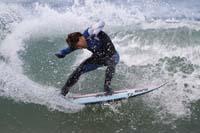
And Urko Esnaola was in charge of the project in Tecnalia. Esnaola, besides specializing in robotics, is a surfer, a project that has allowed us to combine professional and personal interest. "By the way I've learned a lot of things I didn't know about surfing," says Esnaola. "One of the most important things on the table is how it responds to the forces exercised. For example, one of the most commented characteristics by surfers of the table is the flex, that is, the response of the table to longitudinal forces. But even when talking about such things, they are always based on subjective feelings. We proposed to them to turn these feelings into numbers."
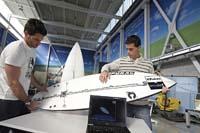
Sensations, number
Thus, to measure the forces placed on the board and its movements, it was decided to place sensors inside the table. Thus Surfsens was born. "We've spent many hours between Pukas' shaper and us deciding which sensors to place, where, how… and we've done a lot of testing," said Esnaola.
The Surfsens table has strain gauge sensors at the bottom to measure strain, such as flex and torsion. That was not enough. Esnaola explains that “we were also interested in knowing the movements of the table to know what works in each maneuver, for example, when you do a cut back (the turn that is made to return to the foam after escaping the zone of breaking the wave), or when you catch the speed, when lowering the wave… For this we have included an electronic with accelerometers, gyroscope, needle and integrated GPS”.
Finally, they needed to know where and with what force the surfer, and to obtain this data pressure sensors have been installed. The table includes a computer to control the data of all these sensors, a battery and a WiFi antenna to send the data to a computer. "When the surfer is in the water, the computer inside the table saves the data in memory and is transmitted to the external computer once extracted from the water," said Esnaola.
One of the major challenges was weight. The boards weigh about 2.5 kg and Surfsens could not weigh much more. Therefore, Tecnalia has made a great effort to reduce the weight of electronics. Finally, the electronic components have managed to weigh 600 g, but those of Pucas have also lightened the materials of the table, so this is not heavier than normal.
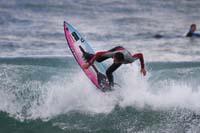
According to Ignacio Abaitua of Puebla, "Surfsens is somewhat heavier than the normal table, but it has good behavior. High level surfers have tested: Aritz Aranburu, Hodei Collazo, Mario Azurza, Kepa Acero... at least they have been very satisfied. And for them it is exciting to see in a computer what behavior they have had in the water, compare the data of one with the other... Everyone wants to know their results."
Data usage
In addition to surfers, Abaitua pointed out that the data are analyzed carefully by shaper: "Surfsens will be very useful for making new models, because instead of testing and failing as usual, we can rely on scientific data. For example, we now know which area of the board is torsional, where it is best to be more flexible and more resistant... and depending on it, and taking into account what the surfer wants, the shaper can mold the materials and appearance to get the most suitable board."
Esnaola reaffirms what Abaitua said: "We finished the first phase of the project with the table and now we are in the second. In this phase, taking advantage of the presence of good surfers in our environment, we want to experiment with them to obtain significant data. For example, we will ask one to always do the same maneuver in all the waves one day, and so, once we have the data, we can draw conclusions."
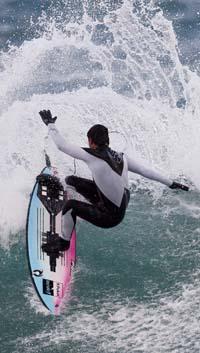
Among its objectives is the realization of the map of critical points of the table, that is, to know which points work in each maneuver. With this information they hope to know which material is convenient to use in each area of the table. "That would be a small revolution because now it's not like that," Esnaola said.
In addition, to improve materials, Tecnalia is also working in another line. In particular, they have adopted a lot of tables provided by Pucas, of different shapes, sizes and models, and have imposed interstitial forces to identify the weakest points. This information will join the information obtained with surfers in the water and will be used to improve the tables.
This is not the only goal. In fact, Esnaola believes that Surfsens can also be used to improve the technique of surfers: "We are thinking of adding artificial intelligence to the table, that is, learning algorithms. From the tests carried out with the board by professional surfers we would generate models, with which the non-professionals would have a tool to improve our activity, since the table itself would tell us, for example, what we have done wrong and what we must do to improve the maneuver".
To advance this path, Tecnalia and Pucas have a great interest in the artificial wave. In Esnaola's opinion it would be wonderful to always take the same wave to have laboratory conditions and have good results. "Because there are no two waves in the sea, so it is impossible for experiments to be conducted under the same conditions," says Esnaola.
Thus, Pucas have already contacted the company Wavegarden. In fact, Wavegarden presented his artificial wave generation system at the same time that Surfsens was introduced. Therefore, the first steps of collaboration have been taken.
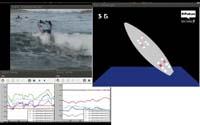
Custom Waves
Although Wavegarden is located in San Sebastian, the first artificial wave has been made on a river bottom of the interior of Gipuzkoa, specifically in Aizarnazabal. The technical director has been Josema Odriozola, who assured that his wave "has no equal". Faced with the technologies that have been used so far, what Wavegarden has developed is completely new.
Odriozola explained that its system is characterized by the quality of the waves they generate, energy expenditure and, finally, the possibility of using it in any environment, even in natural environments: "So far the systems are installed in the pools. On one side of these pools accumulate a huge volume of water that then release forming a wave. Therefore, the appearance and use of the pool are very conditioned. However, we can place our system anywhere with a constant volume of water, for example, in a lake." They did so in Aizarnazabal.
The base of the system is a traction mechanism that drives water. When the water reaches the edge it crashes and returns in the form of a wave. One of the most remarkable elements is the water propeller, which stands out for its "special hydrodynamics", "similar to the wings of the planes". But in order for the wave to be able to surf it is necessary that the bottom of the lagoon is properly designed and that the profile of the shore is adequate, since it depends on the shape of the wave.
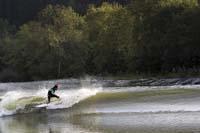
As design is so efficient, energy consumption is three times lower than other waves, according to Odriozola. To achieve this, it took a long time: "There are many factors that influence the formation of the wave: the shovel that drives the water, the forms of background and edges... And to optimize them we had to do many tests, first on the computer, then with the models and finally in the lagoon. The problem is that a change of 5% in the depth of the background, for example, has a huge influence on the aspect of the wave, so we have had to do many tests to get a suitable fund."
Odriozola says that this also happens in the sea: "We are surfers and we know that when the tide drops, for example, in five minutes the characteristics of the wave can change completely." This demonstrates the importance of edge and bottom shapes.
In this way, it is believed that they have achieved an ideal system to create a wave of quality. "In fact, we can create a wave of any length," he said. "For example, a wave of 1.6 meters high, 200 meters long, lasts 20 seconds. The surfer therefore has all that time to surf, and also our system generates two waves at the same time, right and left.
Odriozola claims that these waves can be for professionals. In fact, nine Wavegarden workers are surfers, but in the final phase of the project they called professional surfers to give their last touches. For example, Aritz Aranburu has worked with them on numerous occasions and has helped Wavegarden to strike a balance between the ease and strength of the wave.
However, they have not wanted to limit themselves to surfers and professionals. Thus, they have carried out tests with bodyboard and longboard modalities, children, adults, etc. In short, it is not just about offering a place to train surfers who want to improve their technique, but above all giving the opportunity to anyone who wants to try this sport.
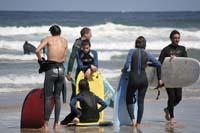
In addition, they consider that their system will be more successful inland than on the coast, "although the current saturation of some coastal areas can also cause demand in coastal villages," said Odriozola. "We have already received numerous requests for information, about 3,000, from many parts of the world: United States, Australia, Brazil, Germany, France, Spain... It has been widely accepted."
Despite being satisfied with the result they have achieved, they want to continue improving. They have contacted several engineering companies to collaborate. In search of the perfect wave.

Gai honi buruzko eduki gehiago
Elhuyarrek garatutako teknologia




